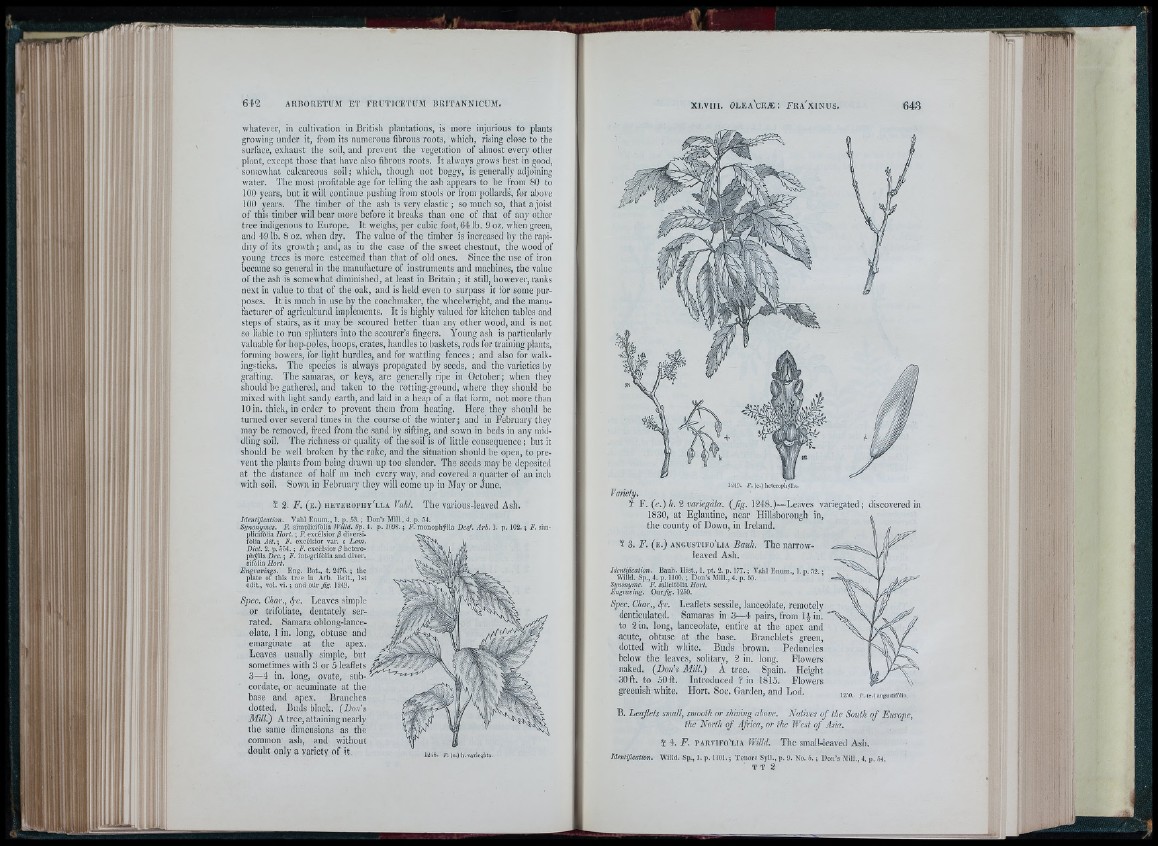
li
È
I; li' I
l ' \ h
-i :.Ì?
I ||||^ i
-Ì'!i
ii’l: i
\ , r
jii U.;
■T' i' 'A ril-i
Ih iv iik
whatever, in cultivation in British plantations, is more injurious to plants
growing untler it, from its niiniei-oiis fibrous roots, which, rising close to the
surface, exhaust the soil, and prevent the vegetation of almost every other
plant, except those tliat have also fibrous roots. Jt always grows best in good,
somewliat calcareous soil; whicli, though not boggy, is generally adjoining
water. The most profitable age for foiling the ash appears to be from 80 to
100 years, but it will continue pushing from stools or from jiollards, for above
100 years. The timber of the ash is very elastic ; so much so, that a joist
of this timber will bear moi'e before it breaks than one of that of any other
tree indigenous to Europe. It weighs, per cubic foot, 64 lb. 9 oz. when green,
and 49 lb. 8 oz. when dry. The value of the timber is increased by the rapidity
of its growtli; and, as in the case of the sweet chestnut, the wood of
young trees is more esteemed than tliat of old ones. Since the use of iron
became so general in the manufacture of instruments and machines, the value
ofthe ash is somewhat diminished, at least in Britain ; it still, however, ranks
next in value to that of the oak, and is held even to surpass it for some purposes.
It is much in use by the coaclimaker, the wheelwright, and the manufacturer
of agricultural imjilemcnts. It is highly valued for kitchen tables and
steps of stairs, as it may be scoured better than an}’ other wood, and is not
so liable lo run splinters into the scourer’s fingers. Ÿoung ash is particularly
valuable for hop-poles, hoops, crates, handles to baskets, rods for training piants,
forming bowers, for light hurdles, and for wattling fences ; and also for walk-
ingsticks. The species is always propagated by seeds, and the varieties by
grafting. The samaras, or keys, are generally ripe in October; when they
should be gathered, and taken to the rotting-ground, where they should be
mixed with light sandy earth, and laid in a hea[> of a flat form, not more than
10 in. thick, in order to prevent them from heating. Here they should be
turned over several times in the course of the winter; and in February they
may be removed, freed from the sand by sifting, and sown in beds in any middling
soil. The richness or quality of the soil is of little consequence ; but it
should bo well broken by the rake, and the situation should be open, to prevent
the plants from being drawn up too slender. The seeds may be deposited
at the distance of half an inch every way, and covered a quarter of an inch
with soil. Sown in February they will come up in May or June.
¥ 2. F. (e .) iie te u o p iiy 'lla Vahl. Tlie various-leaved Ash.
Identification. Vahl Enura., 1. j). 53. ; Don’s Mill, 4. p. 54.
Synonymes. F. simplicifòlia ÌVilìd. Sp. 4. p. I0D8. ; F. monophÿlla Dc-j. Arb. 1. p. 102. ; F. siin-
plicifòlia Hort. ; F. excélsior fi diversifôlia
A it.; F. excélsior var. t Lam.
Dict. 2. p. 554. ; F. excélsior fi heterophÿlla
Dec. ; F. integrifòlia and diver,
sii'ùlia Hort.
Engravings. Eng. Bot., t. 247G. ; the
plate of this tree in Arb. Brit., 1st
edit., vol. vi. ; and oiîr fig. 1249.
Spec. Char., Leaves simple
or trifoliate, dentately serrated.
Samara oblong-lanceolate,
1 in. long, obtuse and
emarginate at the apex.
Leaves usually simple, but
sometimes with 3 or 5 leaflets
3—4 in. long, ovate, sub- ^
cordate, or acuminate at the
base and apex. Branches
dotted. Buds black. {Don's
Mill.) A tree, attniiiing nearly
the same dimensions as the
common ash, and without
doubt only a variety of it ,^„6.
?
i:i i'
I
'. i
1249. F . (e.) hetcrcphÿllH.
Variety,
¥ F. (i.) h. 2 variegâta. {fig. 1248.)—Leaves variegated; discovered in
1830, at Eglantine, near Hillsborough in,
the county of Down, in Ireland.
¥ 3. F. ( e . ) a n g u s t i f o ' l i a Bauh. The narrowleaved
Ash.
Identification. Bauh. H is t, 1. pt. 2. p. 177. ; Valil Enum.. 1. n. 52. •
Willd. Sp., 4. p. 1100. ; Don’s Mill., 4. p. 55.
Synonyme. F. salicifòlia Ilort.
Engraving. Ourfig. 1250.
Spec. Char., Leaflets sessile, lanceolate, remotely
denticulated. Samaras in 3—4 pair.s, from l |i n .
to 2 in. long, lanceolate, entire at the apex and
acute, obtuse at the base. Branchlets green,
dotted with wbite. Buds brown. Peduncles
below the leaves, solitary, 2 in. long. Flowers
naked. {Doris Mill.) A tree. Spain. Fleiglit
30 ft. to 50 ft. Introduced ? in 1815. Flowers
greenish white, llo rt. Soc. Garden, and Lod. ,, .„p,,»,,,
B. Leajicts small, smooth or shining above. Natives of ihe South of Europe,
the North of Africa, or the West of Asia,
¥ 4. F. p a r v i f o ' l i a Willd. The small-leaved Ash.
Identification. Willd. Sp., 1. p. 1101. ; Tenore Syll., p. 9. No. 5. ; Don’s Mill., 4, p. .54.
T T 2